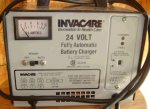First off you need to determine what type of battery you have. If it is a wet cell it will have six caps to check the electrolyte. If it is a AGM/ Hawker it will not have the removable caps.
The AGM battery charges differently than a wet cell battery. First and most importantly about charging then is to never exceed 40amps. In fact, 20 amps is much better. They require a low and slow charging method so as to not heat up and warp the plates or boil the non-replaceable electrolyte. It can easily take a week to charge a “dead” AGM. One of the benefits of the AGM is that they can be pulled down quite far and still be recovered.
Wet cell batteries can be charged at a higher rate as long as the electrolyte level is monitored.
Check the voltage with a multi-meter and if a wet cell reads 12.5 volts or less it needs charged. If an AGM battery reads 12.7 volts or less it needs charged.
As far as the regulator/ charging issue. The alternator should be putting out over 28 volts. If you are only showing 24 volts, the alternator may not be charging at all and the voltage that you are seeing is what the batteries are providing.
To test for that start by turning on the master switch and the run switch just in case. Then check for current at the exciter wire going to the alternator. That is the wire with the plug at the alternator. If there is current, then check the voltage at the batteries. If you really want to get ambitious you can also remove the cover on the alternator and check the voltage there. First with the engine off, then running. The voltmeter could be incorrect. If the voltage is the same when off or even less when the running the alternator is not charging and either the regulator or alternator is bad. Both are an easy fix.




